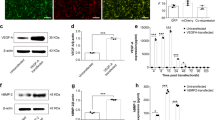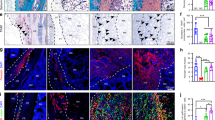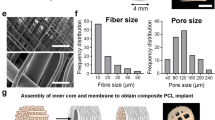Abstract
Gene therapy approaches to bone tissue engineering have been widely explored. While localized delivery of plasmid DNA encoding for osteogenic factors is attractive for promoting bone regeneration, the low transfection efficiency inherent with plasmid delivery may limit this approach. We hypothesized that this limitation could be overcome by condensing plasmid DNA with nonviral vectors such as poly(ethylenimine) (PEI), and delivering the plasmid DNA in a sustained and localized manner from poly(lactic-co-glycolic acid) (PLGA) scaffolds. To address this possibility, scaffolds delivering plasmid DNA encoding for bone morphogenetic protein-4 (BMP-4) were implanted into a cranial critical-sized defect for time periods up to 15 weeks. The control conditions included no scaffold (defect left empty), blank scaffolds (no delivered DNA), and scaffolds encapsulating plasmid DNA (non-condensed). Histological and microcomputed tomography analysis of the defect sites over time demonstrated that bone regeneration was significant at the defect edges and within the defect site when scaffolds encapsulating condensed DNA were placed in the defect. In contrast, bone formation was mainly confined to the defect edges within scaffolds encapsulating plasmid DNA, and when blank scaffolds were used to fill the defect. Histomorphometric analysis revealed a significant increase in total bone formation (at least 4.5-fold) within scaffolds incorporating condensed DNA, relative to blank scaffolds and scaffolds incorporating uncondensed DNA at each time point. In addition, there was a significant increase both in osteoid and mineralized tissue density within scaffolds incorporating condensed DNA, when compared with blank scaffolds and scaffolds incorporating uncondensed DNA, suggesting that delivery of condensed DNA led to more complete mineralized tissue regeneration within the defect area. This study demonstrated that the scaffold delivery system encapsulating PEI-condensed DNA encoding for BMP-4 was capable of enhancing bone formation and may find applications in other tissue types.
This is a preview of subscription content, access via your institution
Access options
Subscribe to this journal
Receive 12 print issues and online access
$259.00 per year
only $21.58 per issue
Buy this article
- Purchase on Springer Link
- Instant access to full article PDF
Prices may be subject to local taxes which are calculated during checkout







Similar content being viewed by others
References
Goldstein SA, Patil PV, Moalli MR . Perspectives on tissue engineering of bone. Clin Orthop 1999; (Suppl 367): S419–S423.
Crane GM, Ishaug SL, Mikos AG . Bone tissue engineering. Nat Med 1995; 1: 1322–1324.
Calvert JW, Weiss LE, Sundine MJ . New frontiers in bone tissue engineering. Clin Plast Surg 2003; 30: 641–648.
Constantz BR et al. Skeletal repair by in situ formation of the mineral phase of bone. Science 1995; 267: 1796–1799.
Petite H et al. Tissue-engineered bone regeneration. Nat Biotechnol 2000; 18: 959–963.
Vacanti CA, Upton J . Tissue-engineered morphogenesis of cartilage and bone by means of cell transplantation using synthetic biodegradable polymer matrices. Clin Plast Surg 1994; 21: 445–462.
Lane JM, Bostrom MP . Bone grafting and new composite biosynthetic graft materials. Instr Course Lect 1998; 47: 525–534.
Lane JM, Tomin E, Bostrom MP . Biosynthetic bone grafting. Clin Orthop 1999; (Suppl 367): S107–S117.
Cao Y, Ibarra C, Vacanti CA . Tissue engineering cartilage and bone. In: Mooney D (ed). Synthetic Biodegradable Polymer Scaffolds. Birkhauser: Boston, 1997, pp 199–214.
Fang J et al. Stimulation of new bone formation by direct transfer of osteogenic plasmid genes. Proc Natl Acad Sci USA 1996; 93: 5753–5758.
Bonadio J, Smiley E, Patil P, Goldstein S . Localized, direct plasmid gene delivery in vivo: prolonged therapy results in reproducible tissue regeneration. Nat Med 1999; 5: 753–759.
Kirker-Head CA . Potential applications and delivery strategies for bone morphogenetic proteins. Adv Drug Deliv Rev 2000; 43: 65–92.
Krebsbach PH, Gu K, Franceschi RT, Rutherford RB . Gene therapy-directed osteogenesis: BMP-7-transduced human fibroblasts form bone in vivo. Hum Gene Ther 2000; 11: 1201–1210.
Shea LD, Smiley E, Bonadio J, Mooney DJ . DNA delivery from polymer matrices for tissue engineering. Nat Biotechnol 1999; 17: 551–554.
Shea LD, Wang D, Franceschi RT, Mooney DJ . Engineered bone development from a pre-osteoblast cell line on three-dimensional scaffolds. Tissue Eng 2000; 6: 605–617.
Ohgushi H, Caplan AI . Stem cell technology and bioceramics: from cell to gene engineering. J Biomed Mater Res 1999; 48: 913–927.
Burg KJ, Porter S, Kellam JF . Biomaterial developments for bone tissue engineering. Biomaterials 2000; 21: 2347–2359.
Griffith LG, Naughton G . Tissue engineering—current challenges and expanding opportunities. Science 2002; 295: 1009–1014.
Bonadio J . Tissue engineering via local gene delivery: update and future prospects for enhancing the technology. Adv Drug Deliv Rev 2000; 44: 185–194.
Olmsted EA et al. Adenovirus-mediated BMP2 expression in human bone marrow stromal cells. J Cell Biochem 2001; 82: 11–21.
Chen Y et al. Gene therapy for new bone formation using adeno-associated viral bone morphogenetic protein-2 vectors. Gene Therapy 2003; 10: 1345–1353.
Laurencin CT et al. Poly(lactide-co-glycolide)/hydroxyapatite delivery of BMP-2-producing cells: a regional gene therapy approach to bone regeneration. Biomaterials 2001; 22: 1271–1277.
Olmsted-Davis EA et al. Use of a chimeric adenovirus vector enhances BMP2 production and bone formation. Hum Gene Ther 2002; 13: 1337–1347.
Sakou T . Bone morphogenetic proteins: from basic studies to clinical approaches. Bone 1998; 22: 591–603.
Linkhart TA, Mohan S, Baylink DJ . Growth factors for bone growth and repair: IGF, TGF beta and BMP. Bone 1996; 19: 1S–12S.
Dayoub H et al. Human mesenchymal stem cells transduced with recombinant bone morphogenetic protein-9 adenovirus promote osteogenesis in rodents. Tissue Eng 2003; 9: 347–356.
Bonadio J, Goldstein SA, Levy RJ . Gene therapy for tissue repair and regeneration. Adv Drug Deliv Rev 1998; 33: 53–69.
Deckers MM et al. Bone morphogenetic proteins stimulate angiogenesis through osteoblast-derived vascular endothelial growth factor A. Endocrinology 2002; 143: 1545–1553.
Akino K, Mineta T, Fukui M, Akita S . P-II-04 early phase regulation of human mesenchymal stem cells and the unique profile of the proliferation by bone morphogenetic protein-2. Wound Repair Regen 2004; 12: A6.
Akino K et al. Bone morphogenetic protein-2 regulates proliferation of human mesenchymal stem cells. Wound Repair Regen 2003; 11: 354–360.
Reddi AH . Bone morphogenetic proteins, bone marrow stromal cells, and mesenchymal stem cells. Maureen Owen revisited. Clin Orthop 1995; (313): 115–119.
Dumont RJ et al. Ex vivo bone morphogenetic protein-9 gene therapy using human mesenchymal stem cells induces spinal fusion in rodents. Neurosurgery 2002; 51: 1239–1244; discussion 1244–1245.
Gysin R et al. Ex vivo gene therapy with stromal cells transduced with a retroviral vector containing the BMP4 gene completely heals critical size calvarial defect in rats. Gene Therapy 2002; 9: 991–999.
Kay MA, Liu D, Hoogerbrugge PM . Gene therapy. Proc Natl Acad Sci USA 1997; 94: 12744–12746.
Romano G, Micheli P, Pacilio C, Giordano A . Latest developments in gene transfer technology: achievements, perspectives, and controversies over therapeutic applications. Stem Cells 2000; 18: 19–39.
Helm GA et al. Utilization of type I collagen gel, demineralized bone matrix, and bone morphogenetic protein-2 to enhance autologous bone lumbar spinal fusion. J Neurosurg 1997; 86: 93–100.
Li SH, De Wijn JR, Layrolle P, de Groot K . Synthesis of macroporous hydroxyapatite scaffolds for bone tissue engineering. J Biomed Mater Res 2002; 61: 109–120.
Whang K et al. Ectopic bone formation via rhBMP-2 delivery from porous bioabsorbable polymer scaffolds. J Biomed Mater Res 1998; 42: 491–499.
Marra KG et al. In vitro analysis of biodegradable polymer blend/hydroxyapatite composites for bone tissue engineering. J Biomed Mater Res 1999; 47: 324–335.
Lunsford L, McKeever U, Eckstein V, Hedley ML . Tissue distribution and persistence in mice of plasmid DNA encapsulated in a PLGA-based microsphere delivery vehicle. J Drug Target 2000; 8: 39–50.
Ando S, Putnam D, Pack DW, Langer R . PLGA microspheres containing plasmid DNA: preservation of supercoiled DNA via cryopreparation and carbohydrate stabilization. J Pharm Sci 1999; 88: 126–130.
Boussif O et al. A versatile vector for gene and oligonucleotide transfer into cells in culture and in vivo: polyethylenimine. Proc Natl Acad Sci USA 1995; 92: 7297–7301.
Huang YC et al. Fabrication and in vitro testing of polymeric delivery system for condensed DNA. J Biomed Mater Res 2003; 67A: 1384–1392.
Winn SR et al. Tissue-engineered bone biomimetic to regenerate calvarial critical-sized defects in athymic rats. J Biomed Mater Res 1999; 45: 414–421.
Hollinger JO, Kleinschmidt JC . The critical size defect as an experimental model to test bone repair materials. J Craniofac Surg 1990; 1: 60–68.
Huang YC, Rice KG, Mooney DJ . Long-term in vivo gene expression via delivery of PEI-DNA condensates from porous polymer scaffolds. Hum Gene Ther (in press).
Opperman LA . Cranial sutures as intramembranous bone growth sites. Dev Dyn 2000; 219: 472–485.
Wozney JM, Rosen V . Bone morphogenetic protein and bone morphogenetic protein gene family in bone formation and repair. Clin Orthop 1998; (346): 26–37.
Turunen MP et al. Efficient adventitial gene delivery to rabbit carotid artery with cationic polymer–plasmid complexes. Gene Therapy 1999; 6: 6–11.
Harris LD, Kim BS, Mooney DJ . Open pore biodegradable matrices formed with gas foaming. J Biomed Mater Res 1998; 42: 396–402.
Acknowledgements
Financial support for this work was provided by the National Institute of Health Grant RO1DE13004 and the US Army Research Laboratory and the US Army Research Office under Grant Number DAAD190310168. We thank the Bone Center (NIH5P30AR46024) at the University of Michigan for assistance in micro-CT analysis, and gratefully acknowledge technical assistance from Ryan Frank.
Author information
Authors and Affiliations
Rights and permissions
About this article
Cite this article
Huang, YC., Simmons, C., Kaigler, D. et al. Bone regeneration in a rat cranial defect with delivery of PEI-condensed plasmid DNA encoding for bone morphogenetic protein-4 (BMP-4). Gene Ther 12, 418–426 (2005). https://doi.org/10.1038/sj.gt.3302439
Received:
Accepted:
Published:
Issue Date:
DOI: https://doi.org/10.1038/sj.gt.3302439
Keywords
This article is cited by
-
Biomaterial-guided delivery of gene vectors for targeted articular cartilage repair
Nature Reviews Rheumatology (2019)
-
A comparison study on the behavior of human endometrial stem cell-derived osteoblast cells on PLGA/HA nanocomposite scaffolds fabricated by electrospinning and freeze-drying methods
Journal of Orthopaedic Surgery and Research (2018)
-
An efficient, non-viral dendritic vector for gene delivery in tissue engineering
Gene Therapy (2017)
-
Biomaterial-mediated strategies targeting vascularization for bone repair
Drug Delivery and Translational Research (2016)
-
Gene therapy for bone tissue engineering
Tissue Engineering and Regenerative Medicine (2016)



